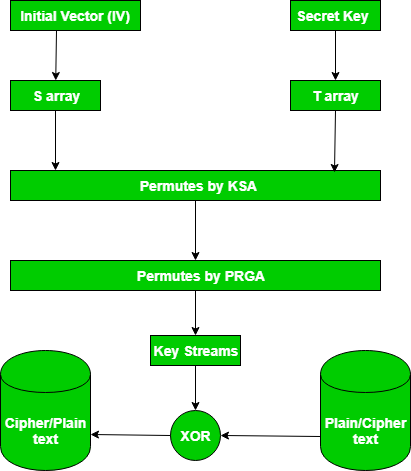RC4 is a stream cipher and variable-length key algorithm. This algorithm encrypts one byte at a time (or larger units at a time). A key input is a pseudorandom bit generator that produces a stream 8-bit number that is unpredictable without knowledge of input key, The output of the generator is called key-stream, is combined one byte at a time with the plaintext stream cipher using X-OR operation.
Example:
RC4 Encryption 10011000 ? 01010000 = 11001000 RC4 Decryption 11001000 ? 01010000 = 10011000
Key-Generation Algorithm – A variable-length key from 1 to 256 bytes is used to initialize a 256-byte state vector S, with elements S[0] to S[255]. For encryption and decryption, a byte k is generated from S by selecting one of the 255 entries in a systematic fashion, then the entries in S are permuted again.
Key-Scheduling Algorithm: Initialization: The entries of S are set equal to the values from 0 to 255 in ascending order, a temporary vector T, is created. If the length of the key k is 256 bytes, then k is assigned to T. Otherwise, for a key with length(k-len) bytes, the first k-len elements of T as copied from K, and then K is repeated as many times as necessary to fill T. The idea is illustrated as follow:
Java
for i = 0 to 255 do S[i] = i;T[i] = K[i mod k - len]; |
we use T to produce the initial permutation of S. Starting with S[0] to S[255], and for each S[i] algorithm swap it with another byte in S according to a scheme dictated by T[i], but S will still contain values from 0 to 255 :
C++
int j = 0;for (int i = 0; i <= 255; i++) { j = (j + S[i] + T[i]) % 256; swap(S[i], S[j]); // Swap S[i] and S[j]} |
Java
j = 0;for i = 0 to 255 do { j = (j + S[i] + T[i])mod 256; Swap(S[i], S[j]); } |
Python3
j = 0for i in range(256): j = (j + S[i] + T[i]) % 256 S[i], S[j] = S[j], S[i] # Swap S[i] and S[j] |
C#
for (int i = 0; i < 256; i++) {j = (j + S[i] + T[i]) % 256;int temp = S[i];S[i] = S[j];S[j] = temp;} |
Javascript
let j = 0;for (let i = 0; i <= 255; i++) { j = (j + S[i] + T[i]) % 256; [S[i], S[j]] = [S[j], S[i]]; // Swap S[i] and S[j]} |
Pseudo random generation algorithm (Stream Generation): Once the vector S is initialized, the input key will not be used. In this step, for each S[i] algorithm swap it with another byte in S according to a scheme dictated by the current configuration of S. After reaching S[255] the process continues, starting from S[0] again
Java
i, j = 0;while (true) i = (i + 1)mod 256;j = (j + S[i])mod 256;Swap(S[i], S[j]);t = (S[i] + S[j])mod 256;k = S[t]; |
Encrypt using X-Or():
News: In September 2015, Microsoft announced the end of using RC4 in Microsoft edge and internet explorer 11. This video gives a clear example of RC4 algorithm.
https://www.youtube.com/watch?v=NKnZARFAhMk
Features of the RC4 encryption algorithm:
- Symmetric key algorithm: RC4 is a symmetric key encryption algorithm, which means that the same key is used for encryption and decryption.
- Stream cipher algorithm: RC4 is a stream cipher algorithm, which means that it encrypts and decrypts data one byte at a time. It generates a key stream of pseudorandom bits that are XORed with the plaintext to produce the ciphertext.
- Variable key size: RC4 supports variable key sizes, from 40 bits to 2048 bits, making it flexible for different security requirements.
- Fast and efficient: RC4 is a fast and efficient encryption algorithm that is suitable for low-power devices and applications that require high-speed data transmission.
- Widely used: RC4 has been widely used in various applications, including wireless networks, secure sockets layer (SSL), virtual private networks (VPN), and file encryption.
- Vulnerabilities: RC4 has several vulnerabilities, including a bias in the first few bytes of the keystream, which can be exploited to recover the key. As a result, RC4 is no longer recommended for use in new applications.
Advantages:
- Fast and efficient: RC4 is a very fast and efficient encryption algorithm, which makes it suitable for use in applications where speed and efficiency are critical.
- Simple to implement: RC4 is a relatively simple algorithm to implement, which means that it can be easily implemented in software or hardware.
- Variable key size: RC4 supports variable key sizes, which makes it flexible and adaptable for different security requirements.
- Widely used: RC4 has been widely used in various applications, including wireless networks, secure sockets layer (SSL), virtual private networks (VPN), and file encryption.
Disadvantages:
- Vulnerabilities: RC4 has several known vulnerabilities that make it unsuitable for new applications. For example, there is a bias in the first few bytes of the keystream, which can be exploited to recover the key.
- Security weaknesses: RC4 has some inherent weaknesses in its design, which make it less secure than other encryption algorithms, such as AES or ChaCha20.
- Limited key length: The maximum key length for RC4 is 2048 bits, which may not be sufficient for some applications that require stronger encryption.
- Not recommended for new applications: Due to its vulnerabilities and weaknesses, RC4 is no longer recommended for use in new applications. Other more secure stream cipher algorithms, such as AES-CTR or ChaCha20, should be used instead.





